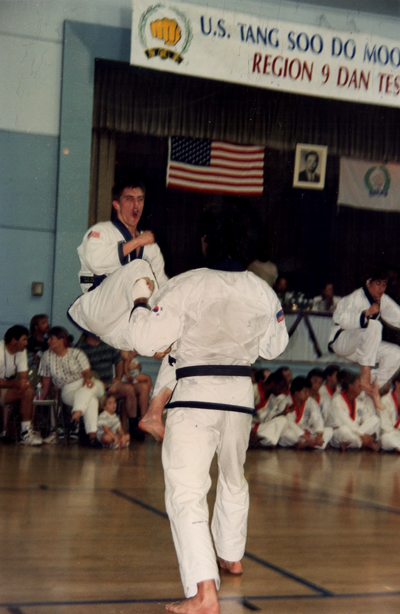
A Korean martial art emerging shortly after the Japanese occupation of Korea in 1945. It is similar to Japanese Karate employing many of the same striking techniques and strategies. A number of the forms found in Tang Soo Do are identical to the forms found within Karate. The martial art is often described as a Korean version of Karate. However there are differences in the application of the hip for the use of generating power in kicking and striking as well as a number of forms developed by Tang Soo Do’s founder Hwang Kee based on his research of ancient martial arts textbooks and the training he had done in China in 1936 under Master Yang Kuk Jin.[1] Traditional Tang Soo Do training includes learning and practice of Stance, Posture, Breathing, Forms, Hand and Foot Strikes, Punching, Kicking, Blocking, Basic Sweeps and Joint Locks.
While Tang Soo Do and many other traditional martial arts have been discarded by several fractions of the martial arts community as being outdated and ineffective in combat. In recent years there have been a number of very successful professional mixed martial arts fighters with backgrounds steeped in traditional styles of of Karate in it’s various forms. Here’s a quick list of some of these martial artists.
- Chuck Liddell trained in Koei-Kan Karate Do under Sensei Jack Sabat and trained in Kajukenbo under John Hackleman.[2] (Kajukenbo a martial art combining the styles of Kempo Karate, Tang Soo Do, Judo, Jujitsu, Chinese Kenpo, and Traditional Chinese Boxing)
- Bas Rutten holds black belts in Kyokushin Karate and Tae Kwon Do.[3]
- Georges St-Pierre Trained in Kyokushin Karate and had earned 2nd degree black belt in the style before becoming a professional MMA fighter.[4]
- Lyoto Machida trained in his family’s style of Karate which incorporates elements of both Japanese Shotokan Karate as well as a number of techniques found in the older Okinawan versions of the Martial Art.[5]
- Chuck Norris trained in Tang Soo Do while stationed in Korea during his military service in the 1950s. Before he became a film star he was a multiple time World and National sparring champion during the golden age of martial arts in the United States.[6]
Although many of these martial artists have trained in an incorporated a number of techniques from sport style martial arts into their game you can still see numerous elements of their traditional karate training emerge in their fights.
References
[1] Kee, Hwang. “Kwan Jang Nim Hwang Kee and His Personal Martial Arts History.” History of Moo Duk Kwan: Celebrating the 50th Anniversary, 1945-1995. United States: Publisher Not Identified, 1995. 8-18. Print.
[2] “Chuck Liddell Bio | The Iceman | Chuck “The Iceman” Liddell.” Chuck The Iceman Liddell RSS. N.p., n.d. Web. 14 Jan. 2016.
[3] “About Bas.” Bas Rutten System. Bas Rutten System, n.d. Web. 14 Jan. 2016.
[4] “Bio.” GSP Offical. N.p., n.d. Web. 14 Jan. 2016.
[5] Slack, Jack. “Lyoto Machida: Old School Karate.” Bleacher Report. N.p., 14 Feb. 2014. Web. 14 Jan. 2016.
[6] Norris, Chuck. “About The Author.” Winning Tournament Karate. Los Angeles: Ohara Publications, 1975. N. pag. Print.
